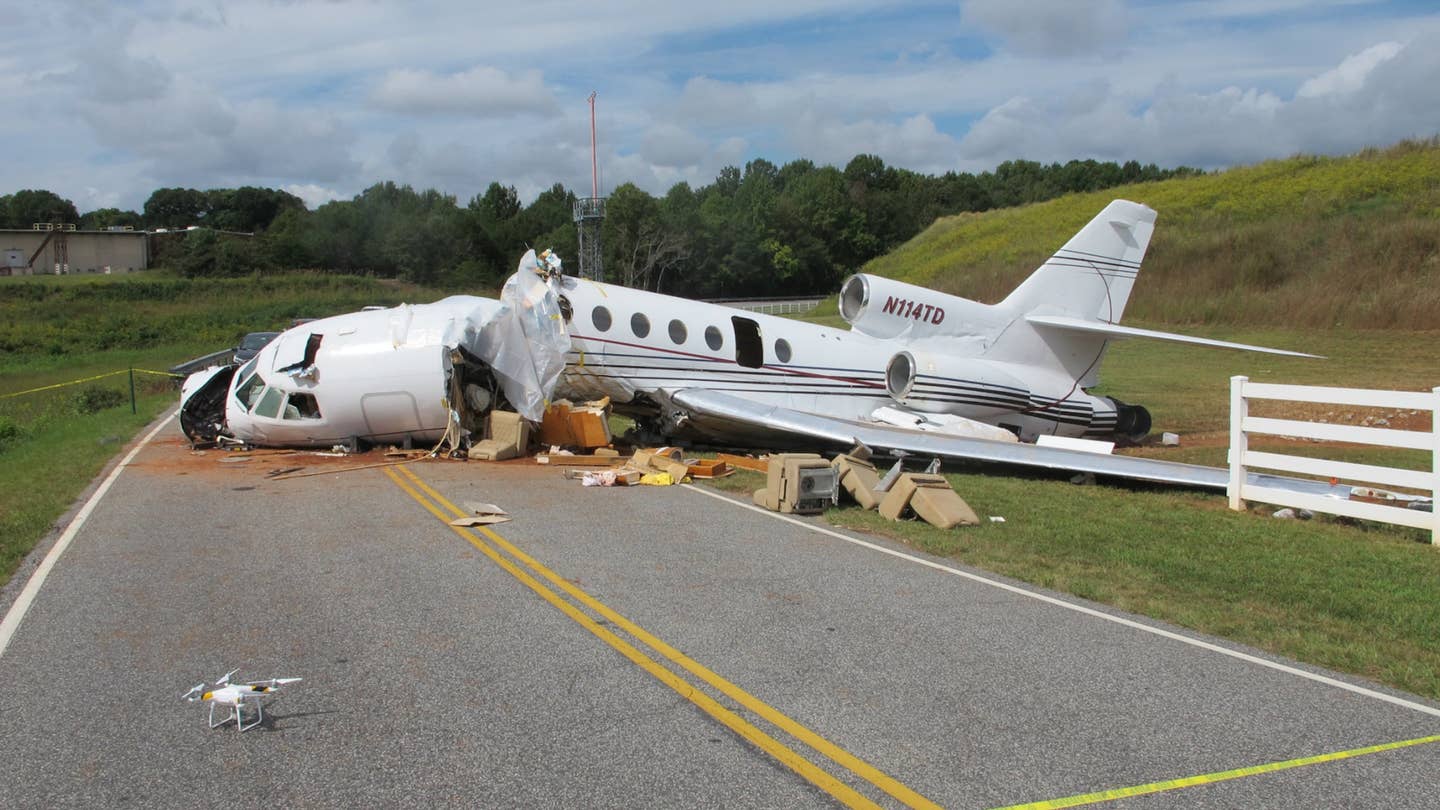
The Falcon 50 broke into two parts after leaving the runway. NTSB
The National Transportation Safety Board determined the probable cause of the accident to be “The operator’s decision to allow a flight in an airplane with known, unresolved maintenance discrepancies, and the flight crew’s failure to properly configure the airplane in a way that would have allowed the emergency or parking brake systems to stop the airplane during landing.” While NTSB reports look directly at the technical aspects of accidents, there are often compelling stories hiding just beneath the surface.
In this particular accident, a Dassault Falcon 50 on an IFR flight plan–N114TD–landing on Runway 19 at Greenville Downtown Airport (GMU) in September 2018 was unable to stop on the 5,393-foot runway once it touched down. The aircraft broke in half as it rolled down an embankment and on to a service road off the end of the runway. The crash claimed the lives of the two pilots and seriously injured the two passengers in the cabin. Though there was no fire, the aircraft was destroyed. The aircraft was operated as an on-demand Part 135 flight by Air America Flight Services Inc.
The NTSB investigation discovered that the accident aircraft had been in storage for four years and was in the process of being returned to a serviceable condition at the time of the accident. One of the major maintenance discrepancies focused on the Falcon’s landing gear that was last overhauled in 2002. The overhaul interval for the gear was 12 years which meant that additional work should have been performed by 2014, or essentially before the aircraft flew again after storage. That gear work was never performed. This also meant that “the electrical harness for the landing gear position sensors and antiskid transducers was [last] removed and replaced,” in 2002.
According to the NTSB report, “A pilot, who had flown the airplane on four previous flights along with the accident pilot, identified during those flights that the airplane’s normal braking system was not operating when the airplane was traveling faster than 20 knots. He remedied the situation by configuring the airplane to use the emergency, rather than normal, braking system. That pilot reported this discrepancy to the operator’s director of maintenance, and it is likely that maintenance personnel from the company subsequently added an ‘INOP’ placard near the switch on the date of the accident. The label on the placard referenced the antiskid system, and the airplane’s flight manual described that with the normal brake (or antiskid) system inoperative, the brake selector switch must be positioned to use the emergency braking system.
Following the accident, the switch was found positioned with the normal braking system activated, and it is likely that the accident flight crew attempted to utilize the malfunctioning normal braking system during the landing. Additionally, the flight crew failed to properly recognize the failure and configure the airplane to utilize the emergency braking system, or utilize the parking brake, as described in the airplane’s flight manual, in order to stop the airplane within the available runway.” The NTSB said, “None of the available maintenance records indicated the brake system issue or showed maintenance actions that were performed to resolve the issue.”
A few facts that could be easily overlooked in the report were the qualifications of the two pilots. A Falcon 50 requires two appropriately rated pilots in order to be operated legally, under Part 91, let alone under Part 135. The captain would have been required to possess a type rating for the Falcon 50. The SIC would have needed at least a commercial pilot certificate with an instrument rating as well as the training required to meet currency in the aircraft.
The NTSB said, “The pilot-in-command held an airline transport pilot certificate and a type rating for the Dassault Falcon 50, but with a limitation for second-in-command privileges only.” The copilot, who was the flying pilot, held only a private pilot certificate with ratings for airplane single and multiengine land. He held no ratings for the Falcon 50, nor did he possess an instrument rating.

Subscribe to Our Newsletter
Get the latest FLYING stories delivered directly to your inbox






